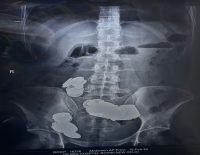First case of Vertebra Stentoplasty on 65-year-old woman in North India

In a first in North India, doctors at a hospital have performed ‘Vertebra Stentoplasty’ – a modern spine surgery on a 65-year-old woman suffering with serious spinal fracture. Stentoplasty is a revolutionary technique where stent is placed within the vertebral body followed by an infusion of cement. It is an effective and quick treatment for acute painful vertebral fracture with progressive collapse.
The patient had a fall at her home in Bihar and was admitted at a city-based hospital in her hometown. The patient was diagnosed with a compression fracture of the L1 vertebra which had led to a significant pain, inability to stand and walk due to the loss of L 1 Vertebra height.
The team of doctors led by Dr Kaushal Kant Mishra, Director, Orthopaedics & Joint Replacement along with Dr. Ravindra Singh Bisht, Consultant, Spine Surgery at Fortis Escorts, Okhla, performed the surgery in mere 25 minutes with the help of the new-age medical procedure.
The patient was admitted in the emergency unit under the observation of Dr Kaushal Kant Mishra. Post medical evaluation, it was observed that there was an osteoporotic compression fracture of the vertebra. The patient also had a medical history of osteoporosis, hypertension, diabetes, coronary artery disease and osteoarthritis. Taking into the consideration, the doctors decided to perform a stentoplasty procedure rather than go ahead with the traditional method of the surgery.
“Stentoplasty is similar to other stenting procedures that uses a titanium stent to aid the kyphoplasty procedure for precision. Vertebral Stentoplasty can be conducted under local anesthesia like cardiac stenting. In stentoplasty, an expandable cage made of titanium is inserted into the collapsed/fractured vertebra. The cage is then expanded inside lifting the collapsed bone and restoring the height. The stents are left inside and finally, the vertebral body and the stents are filled with bone cement. The patient can walk after the surgery as there is fast recovery and there are no complications involved, leading to a better quality of life. In this case, we left the stent inside the vertebra where chances of cement spill are minimal with reduced neurological complications”, said Dr Mishra.








Comments